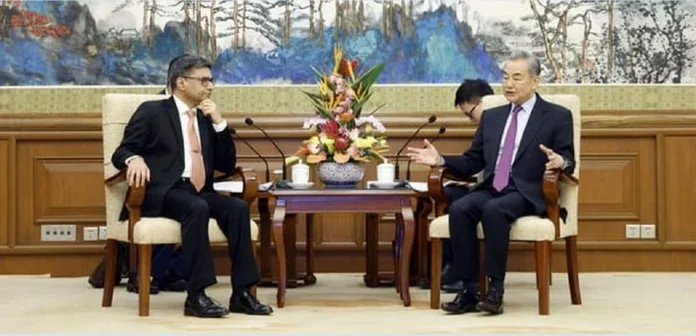By Annunthra Rangan
China’s strategic approach to India can be traced back to the early Cold War era. The 1954 Agreement on Trade and Intercommunication with Tibet introduced the “Five Principles of Peaceful Coexistence,” presenting an image of diplomatic goodwill. However, China’s broader geopolitical calculations were already in motion—this agreement was not solely about India, but part of Beijing’s attempt to counter US containment strategies in Asia.
Premier Zhou Enlai capitalized on India’s non-alignment stance, leveraging it to push a regional agenda that sought to mitigate fears of Chinese expansionism. However, these diplomatic overtures soon proved to be mere strategic manoeuvring. The brutal suppression of the 1959 Tibetan uprising and the 1962 Sino-Indian War exposed China’s dual approach—offering diplomatic niceties while asserting territorial claims.
This pattern has persisted. Prime Minister Narendra Modi, upon taking office in 2014, sought stronger ties with China, even inviting President Xi Jinping for a state visit. Yet, while diplomatic pleasantries were exchanged, Chinese troops intruded into Indian territory in the Demchok and Chumar regions. Despite these setbacks, Modi visited China in 2015, leading to agreements emphasizing “strategic trust” and “military cooperation.”
However, history repeated itself. The 2017 Doklam standoff saw India and China locked in a military confrontation over disputed territory. A brief diplomatic thaw followed, culminating in the Wuhan (2018) and Mamallapuram (2019) summits. But in 2020, Chinese forces reignited tensions along the Line of Actual Control, culminating in the deadly Galwan Valley clash.
The Present Crisis: A Familiar Pattern Repeats
Recent developments in the India-China border dispute reflect a well-worn cycle—temporary peace followed by renewed provocations. China’s establishment of two new counties in Hotan Prefecture, located in Aksai Chin (Indian-claimed Ladakh territory), has triggered fresh tensions. The Indian government swiftly condemned the move, with the Ministry of External Affairs denouncing China’s “illegal and forcible occupation” of Indian land.
This escalation is especially striking given the recent diplomatic efforts to defuse border tensions. In December 2023, National Security Adviser Ajit Doval and Chinese Foreign Minister Wang Yi had engaged in high-level discussions aimed at military disengagement and a new framework for “peace and tranquillity”. Yet, Beijing’s latest territorial assertion has disrupted this progress, reflecting a long-standing Chinese strategy of leveraging border disputes to undermine reconciliation.
In October 2024, India and China reached a crucial agreement to de-escalate tensions in eastern Ladakh. This deal, backed by Modi and Xi during the BRICS summit in Kazan, marked a potential turning point. Subsequent diplomatic exchanges emphasized cooperation, with China’s Ministry of National Defense acknowledging “steady progress” in restoring stability.
During Foreign Secretary Vikram Misri’s meetings in Beijing, India raised key issues, including the resumption of the Kailash Mansarovar Yatra pilgrimage, direct flight connectivity, and visa facilitation for Chinese nationals. India also expressed interest in commemorating the 75th anniversary of diplomatic ties while supporting China’s leadership as chair of the Shanghai Cooperation Organisation.
China, in turn, emphasized the importance of trust-building. Foreign Minister Wang Yi stressed that post-Kazan improvements in bilateral relations should continue, while the Chinese Foreign Ministry reiterated that stronger India-China ties would enhance peace in Asia and the Global South.
Trump’s Return: What It Means For India and China
As India and China attempt to stabilize relations, a new factor enters the equation—Donald Trump’s return to the White House. How will this impact the geopolitical calculus?
Trump’s second term is expected to begin with a more conciliatory tone towards Beijing, but analysts remain skeptical about Washington’s long-term policy. While US-China trade relations may see adjustments, India’s strategic importance within the Quad remains vital in counterbalancing Beijing’s influence in the Indo-Pacific.
Secretary of State Marco Rubio has already signalled continuity in US-India relations, prioritizing a Quad foreign ministers’ meeting immediately after taking office. Historically, India has been a key US partner, and the Modi-Trump rapport is expected to keep New Delhi at the centre of Washington’s strategic considerations.
However, China remains watchful. Beijing closely monitored Indian External Affairs Minister S Jaishankar’s recent visit to Washington—the last under Biden and the first under Trump’s second term. Chinese analysts speculated on whether India aimed to position itself as a viable alternative to China in global supply chains, particularly given Trump’s high tariffs on Chinese goods.
At the same time, Chinese strategists caution that aligning too closely with the US could cost India economically—reducing access to Chinese capital and technology while gaining little from Trump’s unpredictable policies. With China-India relations stabilizing, Beijing sees maintaining a working relationship with India as a strategic advantage.
The Road Ahead: A Delicate Balancing Act
Despite recent progress in India-China relations, New Delhi is unlikely to curtail its diplomatic engagements with Washington. This has led to growing speculation in Beijing about the trajectory of US-India ties in 2025 and their potential implications for China. The historical backdrop is concerning—both the 2017 Doklam standoff and the 2020 Galwan clash occurred during Trump’s first term. Could renewed US-India cooperation under Trump lead to another flare-up with China?
The evolving trilateral dynamic between India, China, and the US is set to shape global geopolitics in 2025. Will India successfully navigate these competing interests, maintaining equilibrium between Washington and Beijing? Or will shifting power dynamics force New Delhi to make hard choices?
With tensions simmering and alliances shifting, the coming months will be critical in determining Asia’s geopolitical landscape.
—The writer is a Senior Research Officer at Chennai Centre for China Studies. Her research interests constitute China-WANA (West Asia and North Africa) relations and human rights


